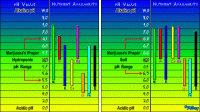Oh ya I water every 2-3 days where the pot is light with 10 -20% run off always test my pH and ppm, ppm is different for all the plants though none of them the same, some at 700 some at 1000, pH between 5.8 and 6.2
Coco is a hydroponic media, your nutrient solution should be around 5.8 to 5.9 (some variance is okay, but
not the 6.5 to 6.8 you're trying for. You're mixing up your nutrient solution, then testing its pH, determining it to be somewhere between 5.8 (which is fine) and 6.2 (too high), then you're adding some sort of pH Up product and it's not changing? Yeah, that's a pH meter issue, as others have pointed out. And a significant one, at that; even if it was out of calibration, raising the pH of your nutrient solution would still cause a functional pH meter to show an increase when you tested that solution (it just wouldn't show the correct pH). And why are you feeding all of your plants different strength nutrient solutions, lol?
that's not under watering
All things considered, the person probably was underwatering. Not watering frequently enough, anyway. He (or she, whichever applies) appears to be a newbie grower, is running coco in fabric containers... and only recently learned that he/she is trying to grow in coco. And once that stuff dries out, it seems to still have "pockets" of dry media here and there even after the gardener thinks it has been fully hydrated again, for some reason. Which tends to cause issues.
Come to think of it... I wonder if the OP even knew to rinse, rinse, rinse the coco before using it? And to presoak it in something like a weak calcium nitrate solution with a bit of Epsom salt (or other source of magnesium) in order to exchange the sodium and potassium ions that it's naturally loaded with for calcium (and magnesium, although that part isn't strictly necessary). Which means OP is likely to have calcium-related issues throughout the grow.
If someone gave those plants to me, I'd try to figure out a way to place them into non-porous containers (with drain holes only on the bottom) and give them a soak in a weak Ca(NO
3)
2 solution overnight, possibly by using my bathtub due to the size of the plants/containers. If that would be deep enough? Although at least two companies that sell the stuff states that the soak should last for two days:
How do I buffer cocopeat?
A very simple method is to use a bunker (washbay) system to buffer the cocopeat. It can be done in lots of 25, 50, 75, 100, 125 or 150 cubic meters at a time – depending on the size of your washbay.
The first step is to hydrate or expand the cocopeat completely. Once expanded, leave the cocopeat until these is no more water runoff.
The next step is to mix Calcium Nitrate at a ratio of 8 Kilos per 1,000 litres of water.
The recommended buffering ratio is 200 litres of treated water (i.e. water mixed with Calcium Nitrate) per 1 Cubic Meter (or +/- 15 x 5kg blocks) of cocopeat – alternatively: 1,000 litres of water mixed with 7 kg of Calcium Nitrate will buffer 5 Cubic Meters of cocopeat. Ideally the treated water should be administered over a 24 hour period via a slow sprinkler system if possible.
After the treated water has been applied, leave the heap for 2 days for the buffer to take full effect and for optimum results.
Once the resting period is over, rinse the cocopeat once more – i.e. let the all the water runoff, fill the washbay again with water and let it then run off once more.
Now you will have buffered cocopeat.
It is suggested that a totally soluble CANO (Calcium Nitrate) is used if available. Field grade CANO can also be used if the mixture is adequately agitated to dissolve the particles.
The method described above is the best, most practical and simplest of buffering methods. If sprinklers are not available, one can simple soak the cocopeat in the treated water – just ensure that the cocopeat and water are well mixed.
150 cubic meters of the stuff, LMAO. If I'm not mistaken, that's about 9,600 gallons more than the capacity of the average 20'x40' inground swimming pool. I'm guessing that they sell to more than just hobby growers

.
DISCLAIMER: I am
not any kind of coco expert, and rarely grow plants in it. And I'm thinking that an expert is what you need.
Assuming you are certain that what you have is coco mixed with that perlite, it might be beneficial to use that "Report" (post) link at the bottom of post #1 to ask the staff to move this thread to our "Coco" section, where it'll get seen by the people who should know a lot about the stuff.












 .
.




